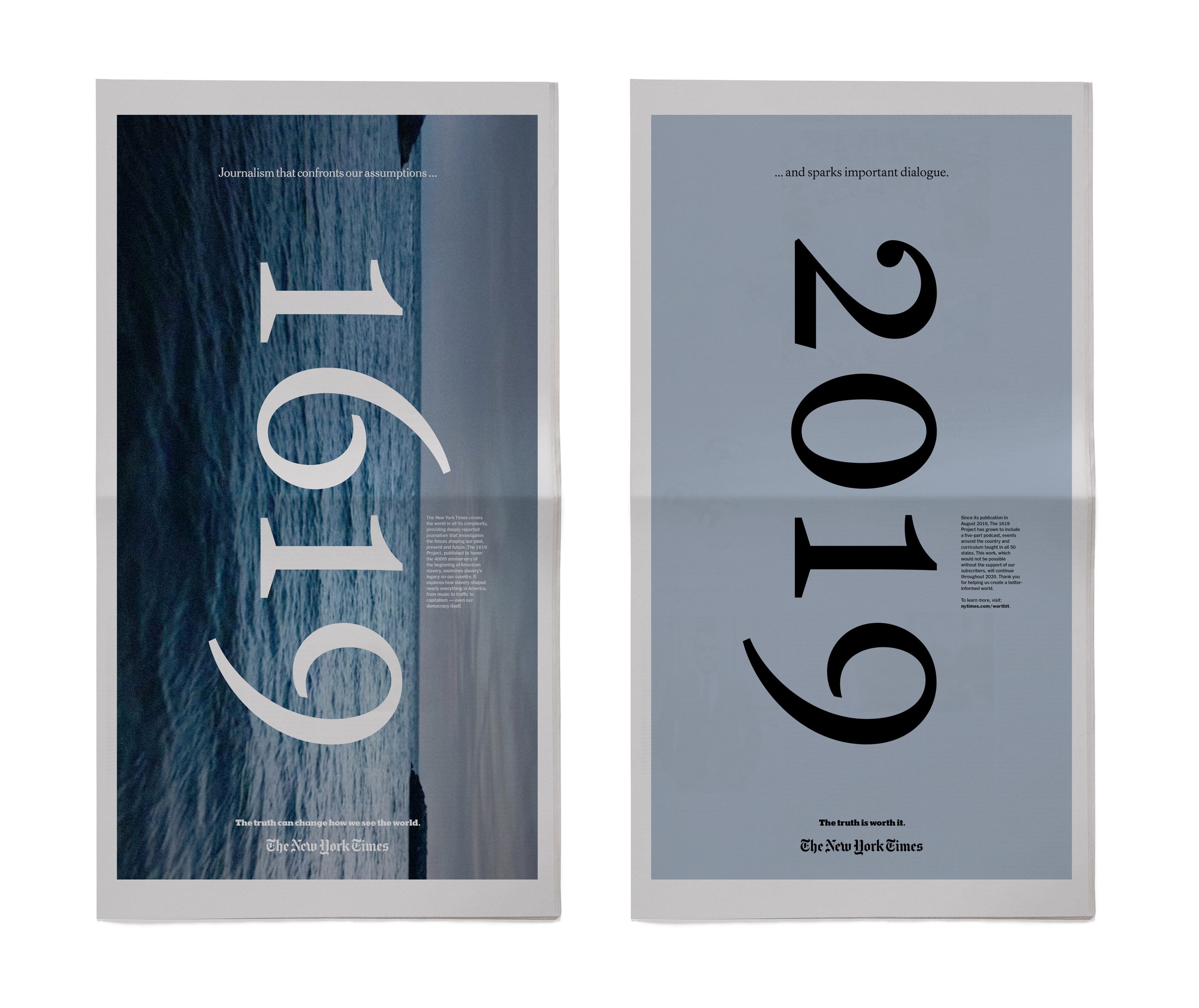
The New York Times is using one of its most prominent — and provocative — editorial projects to market itself to current and potential subscribers, starting with movie fans.
On Sunday, during the 92nd Academy Awards telecast on ABC, the Times will kick off a national ad campaign with a commercial highlighting The 1619 Project, its package of stories last August marking the 400th anniversary of the first documented enslaved Africans to reach the British colonies and retelling American history through the lens of slavery, race, and discrimination.
The sweeping, deeply-reported project on how slavery has shaped America was one of the most-read pieces of journalism the Times produced in 2019. Originally conceived by Times reporter Nikole Hannah-Jones as a special issue of The New York Times Magazine, The 1619 Project has grown to include a special section in the paper, a live event series, curriculum materials, podcasts, books, and even a yet-to-be-launched merchandise collection in collaboration with the African American Cultural Heritage Action Fund. Now it includes an ad starring Janelle Monáe.
With “The Truth Is Worth It” campaigns, first launched in 2017, the Times hopes to convince more of its 150 million monthly readers to pay for a subscription, said senior vice president of marketing Amy Weisenbach. Unsurprisingly, they’re also hoping to instill the belief that quality journalism — Times journalism, in particular — is worth paying for.
“I think people simply don’t know what goes into producing the kind of journalism that The New York Times produces,” Weisenbach said, citing the 1,700 Times journalists in New York and across the globe. “We see our work as helping people understand what goes into our journalism.”
The Times’ marketing and media department is also fighting to dispel myths about how the Times stays afloat, Weisenbach said. Two-thirds of the paper’s revenue comes from subscriptions, not ad dollars or a wealthy benefactor, as she said some readers believe.
The 30-second spot features singer/actor/producer Monáe on the Virginia shore where, in 1619, the first enslaved Africans arrived. (The same location inspired the cover for The 1619 Project’s magazine edition, which had crowds lining up outside the Times building last August.)After soliciting feedback and sharing a shortlist with the project’s creator Hannah-Jones and magazine editor Jake Silverstein, the Times’ marketing team ultimately chose artist and filmmaker Jenn Nkiru to direct the starkly-shot ad. “No aspect of the country we know today has been untouched by the slavery that followed,” Monáe says in the ad, drawing on the 1619 Project’s opening words. “America was not yet America, but this was the moment it began.”
The Times has some recent history with the Oscars, which is known as the second most expensive show to buy ads for after the Super Bowl. (It drew 29.6 million viewers last year.) In 2017, a month into Donald Trump’s presidency, it used the broadcast to debut its truth-themed campaign, its first significant brand marketing on TV in a decade. (It skipped the broadcast in 2018 and 2019.)
Putting The 1619 Project front and center is fitting, given its outsized cultural impact; it’s prompted hundreds of stories in other outlets and endless discussion (some of it even civil) on Twitter. The New York Times Company’s online corporate history ranks it alongside the Pentagon Papers and exposing Boss Tweed as moments where the Times showed “fearless journalism can hold power to account and spur change.”
But the project has also sparked controversy in a few circles — some expected (conservatives who prefer to downplay the foundational role of slavery and racism in American history), some semi-expected (a small group of colonial-era historians who argue for a more triumphalist narrative), and some quasi-confusing (Trotskyist Marxists!). It’s as hot of a cultural hot potato as the Times has baked in a long time.
Previous iterations of the Times’ Truth campaign had focused primarily on dogged investigative and watchdog reporting — on the Rohingya in Myanmar, on the failings of the New York subway system, on climate change’s impact on the Galapagos, on dubious Donald Trump tax schemes, on spying by the Mexican government, on migrant family separation, on the internal workings of the Islamic State. Those ads lean on the raw horsepower of the Times newsroom, those 1,700 journalists able to take on the sorts of ambitious investigations few others can.
So choosing to tie its marquee promotion to The 1619 Project — a culture-shifting project based more on history and storytelling than on uncovering some new Trump Administration scandal — seems to broaden the paper’s idea of what Truth is, as they say, Worth It — “it” being your subscription dollars. And by picking perhaps the piece of recent Times journalism that most angered those on the political right, it also seems to show a Times confident in its position within this polarized country.
This iteration of The Truth Is Worth It campaign will include the TV commercial, print advertising, and social media and digital spots. Weisenbach declined to specify how much the Times has invested in brand marketing overall or this campaign in particular, but buying 30 seconds of commercial time during this year’s Oscars costs upwards of $2.6 million.
The marketing dollars seem to be paying off. Last month, the Times announced it hit a new milestone with 5 million total subscribers, including a million new subscribers in 2019. “That’s not only a record for the Times, but a record for paid journalism,” Weisenbach said.